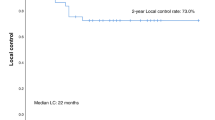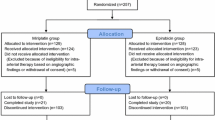Abstract
Background
Injection of a suspension of miriplatin into the hepatic artery has been employed for the treatment of hepatocellular carcinoma (HCC). The efficacy and safety of transcatheter arterial chemoembolization (TACE) using miriplatin were evaluated.
Methods
A total of 236 patients with unresectable HCC received miriplatin administration through the hepatic artery, followed by embolization with porous gelatin particles. The efficacy of this treatment modality was evaluated by contrast-enhanced computed tomography performed 1 month later and its safety based on the Common Terminology Criteria for Adverse Events (CTCAE).
Results
Miriplatin was used at a median dose of 66 mg. The therapeutic efficacy was evaluated in 130 patients, and the overall and complete response rates were 70.0 and 37.7%, respectively. The efficacies differed depending on the staging and Japan integrated staging (JIS) scores of the HCCs, with the overall and complete response rates being 87.7 and 66.7% for stage I and stage II HCC, and 56.2 and 15.1% for stage III and stage IV HCC, respectively; the corresponding rates were 93.2 and 70.5%, respectively, for HCCs with score 0 and score 1, and 58.1 and 20.9%, respectively, for those with scores 2–4. The stage of HCC was a significant independent factor associated with curative effects of TACE using miriplatin. Grade 3 elevation of serum transaminase levels was found in 23.4% of the patients; however, the values returned to the baseline levels.
Conclusions
Miriplatin is a useful and safe agent for TACE in patients with HCC stage I or II and/or JIS score 0 or 1 only when radiofrequency ablation and liver resection cannot be performed.
Similar content being viewed by others
References
Umemura T, Ichijo T, Yoshizawa K, Tanaka E, Kiyosawa K. Epidemiology of hepatocellular carcinoma in Japan. J Gastroenterol. 2009;44(Suppl):102–7.
Arii S, Sata M, Sakamoto M, Shimada M, Kumada T, Shiina S, et al. Management of hepatocellular carcinoma: report of consensus meeting in the 45th annual meeting of the Japan Society of Hepatology (2009). Hepatol Res. 2010;40:667–85.
Ikai I, Arii S, Ichida T, Okita K, Omata M, Kojiro M, et al. Report of the 16th follow-up survey of primary liver cancer. Hepatol Res. 2005;32:163–72.
Imamura H, Matsuyama Y, Tanaka E, Ohkubo T, Hasegawa K, Miyagawa S, et al. Risk factors contributing to early and late phase intrahepatic recurrence of hepatocellular carcinoma after hepatectomy. J Hepatol. 2003;38:200–7.
Rossi S, Buscarini E, Garbagnati F, Garbagnati F, Stasi MD, Quaretti P, et al. Percutaneous treatment of small hepatic tumors by an expandable RF needle electrode. Am J Roentgenol. 1998;170:1015–22.
Arii S, Yamaoka Y, Futagawa S, Inoue K, Kobayashi K, Kojiro M, et al. Results of surgical and nonsurgical treatment for small-sized hepatocellular carcinomas: a retrospective and nationwide survey in Japan. The Liver Cancer Study Group of Japan. Hepatology. 2000;32:1224–9.
Mazzaferro V, Regalia E, Doci R, Andreola S, Pulvirenti A, Bozzetti F, et al. Liver transplantation for the treatment of small hepatocellular carcinomas in patients with cirrhosis. N Engl J Med. 1996;334:693–9.
Llovet JM, Real MI, Montana X, Planas R, Coll S, Aponte J, et al. Arterial embolisation or chemoembolisation versus symptomatic treatment in patients with unresectable hepatocellular carcinoma: a randomised controlled trial. Lancet. 2002;359:1734–9.
Sumie S, Yamashita F, Ando E, Tanaka M, Yano Y, Fukumori K, et al. Interventional radiology for advanced hepatocellular carcinoma: comparison of hepatic artery infusion chemotherapy and transcatheter arterial lipiodol chemoembolization. Am J Radiology. 2003;181:1327–34.
Okusaka T, Kasugai H, Ishii H, SM-11355 Japan Study Group. A randomized phase II trial of intraarterial chemotherapy using a novel lipophilic platinum derivative (SM-11355) in comparison with zinostatin stimalamer in patients with hepatocellular carcinoma. J Clin Oncol. 2009;27:222s.
Takayasu K, Shima Y, Muramatsu Y, Moriyama N, Yamada T, Makuuchi M, et al. Hepatocellular carcinoma: treatment with intraarterial iodized oil with and without chemotherapeutic agents. Radiology. 1987;163:345–51.
Takayasu K, Arii S, Ikai I, Kudo M, Matsuyama Y, Kojiro M, et al. Overall survival after transarterial lipiodol infusion chemotherapy with or without embolization for unresectable hepatocellular carcinoma: propensity score analysis. Am J Radiol. 2010;194:830–7.
The Liver Cancer Study Group of Japan. The general rules for the clinical and pathological study of primary liver cancer. Tokyo: Kanehara; 2003.
Kudo M, Cung H, Osaki Y. Prognostic staging system for hepatocellular carcinoma (CLIP score): its value and limitations, and a proposal for a new staging system, the Japan integrated staging score (JIS score). J Gastroenterol. 2003;38:207–15.
National Cancer Institute. Common terminology criteria for adverse events (CTCAE), version 4.0. 2011. http://evs.nci.nih.gov/ftp1/CTCAE/. Accessed 9 May 2011.
Nakakuma K, Tashiro S, Hiraoka T, Ogata K, Ootsuka K. Hepatocellular carcinoma and metastatic cancer detected by iodized oil. Radiology. 1985;154:15–7.
Taguchi T, Saito T, Ota J, Nakao I, Ohashi K, Nakamura H, et al. Phase II study of YM881 (zinostatin stimalamer) suspension injected into the hepatic artery. Jpn J Cancer Chemother. 1991;18:1665–75.
Maeda H, Uchida NA, Sasaki T. Liposoluble platinum(II) complexes with antitumor activity. Jpn J Cancer Res. 1986;77:523–5.
Kishimoto S, Noguchi T, Yamaoka T, Fukushima S, Takeuchi Y. In vitro release of SM-11355, cis[((1R,2R)-1,2-cyclohexanediamine-N,N’)bis(myristato)] platinum (II) suspended in lipiodol. Biol Pharm Bull. 2000;23:637–40.
Hanada M, Baba A, Tsutsumishita Y, Noguchi T, Yamaoka T, Chiba N, et al. Intra-hepatic arterial administration with miriplatin suspended in an oily lymphographic agent inhibits the growth of tumors implanted in rat livers by including platinum-DNA adducts to form and massive apoptosis. Cancer Chemother Pharmacol. 2009;64:473–83.
Ikeda M, Maeda S, Shibata J, Muta R, Ashihara H, Tanaka M, et al. Transcatheter arterial chemotherapy with and without embolization in patients with hepatocellular carcinoma. Oncology. 2004;66:24–31.
Ono Y, Yoshimaru T, Ashikaga R, Inoue M, Shindou H, Fuji K, et al. Long-term results of lipiodol-transcatheter arterial embolization with cisplatin or doxorubicin for unresectable hepatocellular carcinoma. Am J Clin Oncol. 2000;23:564–8.
Yodono H, Matsuo K, Shinohara A. A retrospective comparative study of epirubicin-lipiodol emulsion and cisplatin-lipiodol suspension for use with transcatheter arterial chemoembolization for treatment of hepatocellular carcinoma. Anti-Cancer Drugs. 2011;22:277–82.
Kawamura Y, Ikeda K, Hirakawa M, Hosaka T, Kobayashi M, Saitoh S, et al. Efficacy of platinum analogue for advanced hepatocellular carcinoma unresponsive to transcatheter arterial chemoembolization with epirubicin. Hepatol Res. 2009;39:346–54.
Yoshikawa M, Ono N, Yodono H, Ichida T, Nakamura H. Phase II study of hepatic arterial infusion of a fine-powder formulation of cisplatin for advanced hepatocellular carcinoma. Hepatol Res. 2008;38:474–83.
Acknowledgments
This study was supported in part by Grants-in-Aid from the Ministry of Health, Labor, and Welfare of Japan to Research on Hepatitis.
Conflict of interest
The authors declare that they have no conflict of interest.
Author information
Authors and Affiliations
Corresponding author
Rights and permissions
About this article
Cite this article
Imai, Y., Chikayama, T., Nakazawa, M. et al. Usefulness of miriplatin as an anticancer agent for transcatheter arterial chemoembolization in patients with unresectable hepatocellular carcinoma. J Gastroenterol 47, 179–186 (2012). https://doi.org/10.1007/s00535-011-0475-x
Received:
Accepted:
Published:
Issue Date:
DOI: https://doi.org/10.1007/s00535-011-0475-x




